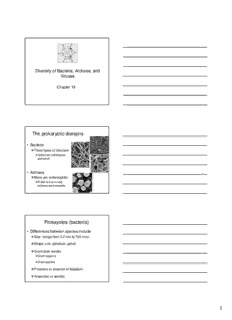
Diversity of Bacteria, Archaea, and Viruses - WOU Homepage PDF
Preview Diversity of Bacteria, Archaea, and Viruses - WOU Homepage
Diversity of Bacteria, Archaea, and Viruses Chapter 19 The prokaryotic domains • Bacteria (cid:1)Three types of structure (cid:2)Spherical, rod-shaped, and spiral • Archaea (cid:1)Many are extremophilic (cid:2)Prefer to live in very extreme environments. Prokayotes (bacteria) • Differences between species include (cid:1)Size (range from 0.2 mm to 700 mm). (cid:1)Shape (rod, spherical, spiral) (cid:1)Gram stain results (cid:2)Gram negative (cid:2)Gram positive (cid:1)Presence or absence of flagellum. (cid:1)Anaerobic vsaerobic 1 Prokaryotes and animals • Prokaryotes are important for animal nutrition (cid:1)Herbivores need bacteria to digest cellulose (cid:1)Humans need bacteria to make Vitamin K & vitamin B12. (cid:1)Termites need bacteria to digest wood. Bacteria and plants • Nitrogen fixing bacteria (cid:1)Live in the soil (cid:1)Help legumes (beans) trap nitrogen Bacteria are recyclers • Decompose organic matter (cid:1)Releases nutrients back into the environment • Clean up pollution (bioremediation) (cid:1)Break down a lot of chemicals (cid:1)A hot area of research for oil spills. 2 Pathogenic bacteria • Pathogenic: produces disease. (cid:1)Many anaerobic bacteria cause disease (cid:2)Botulism, tetanus (cid:1)Bubonic plague (black death) (cid:1)Leprosy (cid:1)Tuberculosis A virus is a nucleic acid molecule with a protein coat. A. Structure of Viruses: Infectious particles consisting of: (cid:1) Nucleic acid genome (DNA or RNA) (cid:1) Protein coat = capsid (cid:1) Lipid bilayer= envelope Capsids and Envelopes Main capsidtypes: • Polyhedrons • Helical (rods) 3 Envelopes Contain membrane glycoproteins: Bind to specific host cell protein = “viral receptor” (cid:1)remember that glycoproteinsact as identifying signals. Features of viral reproductive cycles Parasite: an organism (?) that benefits by living in or on another organism (its host) at the expense of that organism. Obligate intracellular parasites Viruses cannot reproduce without a host cell. No way to undergo mitosis or meiosis. Viruses require from hosts: • enzymes • ATP • ribosomes, etc. • monomers (NTs, amino acids) Rabies virus Ebola virus 4 Host Range: the limited group of organisms / cell types that can be infected by a particular virus e.g., West Nile Virus Bacteriophage:virus that infects bacteria (cid:1)Can be beneficial to humans if it targets a pathogenic bacteria. (cid:1)Phages will destroy bacteria during reproduction. Bacteriophage life cycle 5 What dictates host range? Ability of virus to gain entry (most important) Glycoproteinsthat aren’t recognized are rejected by the cell. viral surface protein viral receptor 2. Fusion of viral envelope with plasma membrane Viral reproductive cycle (DNA virus) 6 Concept 18.2 -Viruses, viroidsand prions are formidable pathogens A. Viral diseases in animals / emerging viruses. Pathogenic virus:a disease- causing virus Emerging viruses: sudden appearance (or sudden medical importance) Examples: Avian bird flu Where do emerging viruses come from? 1. Mutation of existing viruses RNA viruses: very high mutation rate 2. “Jumping”species (cid:1)Frequently involve swine or birds 3. Spread from small isolated populations Viral vaccines Viruses or viral components used to stimulate immune system defenses (without causing the disease). • Major types: (cid:1)Live (weakened) virus (cid:2)Polio virus, measles, mumps (cid:1)Killed virus (cid:2)Flu shots, hepatitis A (cid:1)Viral protein(s) (cid:2)Human papillomavirus (HPV) 7 Humans: H1N1 -1918 “Spanish flu” H2N2 -1957 “Asian flu” H3N2 -1968 “Hong Kong flu” H5N1 -2005 “Avian flu” Transmission of influenza A All flu viruses originate in aquatic birds (= reservoir) Why are we fearful about H5N1 (avian flu)? 8 1. Avian H5N1 in humans is highly pathogenic. (cid:1) But not easily transmitted: (cid:2) Poultry to human (cid:2) Human to human 2. Humans would have little/no immunity to this strain. Immunity No immunity HA (a foreign protein) What makes a particular strain pathogenic? UUUUnnnnkkkknnnnoooowwwwnnnn!!!! 1918 strain (Spanish flu) -“resurrected” 9 Pathogenic viruses • Smallpox (cid:1)Oldest known viral disease (cid:2)First records in 150 A.D. (cid:1)Disastrous for North American natives (cid:1)Why? • World-wide vaccination helped to nearly eradicate smallpox. (cid:1)Two known repositories (cid:2)Atlanta, Georgia (cid:2)Russia Pathogenic viruses • Human papillomavirus (cid:1)Almost all cases of cervical cancer is due to HPV. (cid:1)Cervical cancer survival rate has improved with pap smears and other screening. (cid:2)Stage 1: 80 –90% survive (cid:2)Stage 2: 50 –55% survive (cid:2)Stage 3: 15 –25% survive • HPV is sexually transmitted. Pathogenic viruses • Mumps and measles (cid:1)Mumps is not deadly (cid:2)But can cause sterility, especially in infected adult men. (cid:1)Measles is highly contagious (cid:2)90% of exposed people will develop measles. (cid:2)German measles (rubella) in pregnant women will cause serious birth defects in fetus 10
Description: